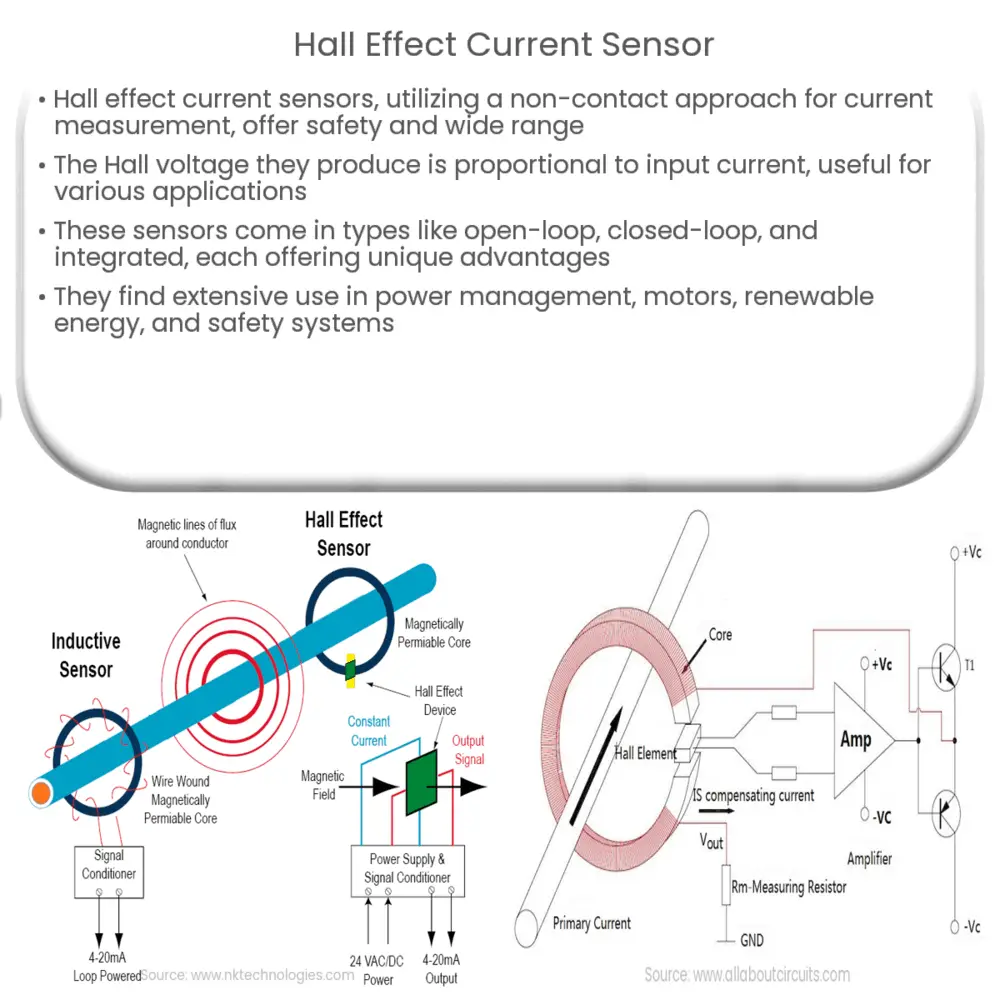A Hall effect current sensor is a non-contact device that measures electrical currents by detecting magnetic fields generated by current flow.

Hall Effect Current Sensors: A Comprehensive Guide
Introduction
Hall effect current sensors are widely used in various industries due to their non-intrusive and non-contact approach to current measurement. These sensors are based on the Hall effect, a phenomenon discovered by Edwin Hall in 1879. This article will provide an in-depth understanding of Hall effect current sensors, their working principle, advantages, and applications.
Understanding the Hall Effect
The Hall effect is a phenomenon that occurs when an electric current flows through a conductor in the presence of a magnetic field. This interaction results in a voltage difference, called the Hall voltage, across the conductor perpendicular to both the current flow and the magnetic field. The Hall voltage is directly proportional to the strength of the magnetic field and the current flowing through the conductor. The Hall effect forms the basis for the operation of Hall effect current sensors.
Working Principle of Hall Effect Current Sensors
Hall effect current sensors consist of a Hall effect sensor, which is placed close to the current-carrying conductor. When a current flows through the conductor, it generates a magnetic field proportional to the current. The Hall effect sensor, placed in this magnetic field, generates a Hall voltage that is proportional to the strength of the magnetic field, and thus, the current.
The Hall voltage is then measured and processed by an amplifier and signal conditioning circuitry to produce an output signal, typically a voltage or current, which is proportional to the input current. This output signal can then be used for various control, protection, and measurement applications.
Advantages of Hall Effect Current Sensors
Hall effect current sensors offer several advantages over other current measurement techniques, such as:
- Non-contact measurement: Since the sensor does not need to be in direct contact with the conductor, it reduces the risk of electrical shock and increases safety.
- Galvanic isolation: The sensor provides galvanic isolation between the measured current and the output signal, reducing the risk of electrical noise and interference.
- Wide measurement range: Hall effect current sensors can measure a wide range of currents, from small milliampere-level signals to large kiloampere-level currents.
- High-speed response: These sensors have a fast response time, making them suitable for high-speed applications and transient current measurements.
- Low insertion loss: The non-contact nature of Hall effect sensors results in minimal power loss during the measurement process.
In the next part of this article, we will discuss the various types of Hall effect current sensors, their applications, and how to choose the right sensor for your specific requirements.
Types of Hall Effect Current Sensors
Hall effect current sensors are available in various types, each with specific features and benefits. Some common types include:
- Open-loop sensors: These sensors have a single Hall element and provide an output signal proportional to the measured current. They are cost-effective and offer a wide measurement range, but may have lower accuracy and temperature stability compared to closed-loop sensors.
- Closed-loop sensors: Closed-loop sensors have a feedback loop that compensates for the sensor’s temperature drift and other errors, resulting in higher accuracy and stability. These sensors typically use a secondary winding or a magnetic core to generate a counteracting magnetic field, effectively canceling out the effect of the primary current on the Hall element.
- Integrated sensors: Integrated Hall effect current sensors combine the Hall effect sensor, signal conditioning, and sometimes even the magnetic concentrator into a single package, providing a compact and easy-to-use solution.
Applications of Hall Effect Current Sensors
Hall effect current sensors are widely used across various industries and applications, such as:
- Power management: In power supplies, inverters, and battery management systems, current sensors are crucial for monitoring and controlling power flow.
- Motors and drives: Current sensors are used to monitor and control motor current in industrial automation, robotics, and electric vehicle applications.
- Renewable energy: Current sensors are used in solar and wind energy systems to ensure efficient and safe operation.
- Protection and safety: In circuit breakers and fault detection systems, current sensors are used to detect and isolate faults, ensuring system safety.
Choosing the Right Hall Effect Current Sensor
When selecting a Hall effect current sensor for your application, consider the following factors:
- Measurement range: Choose a sensor with a current range that matches your application requirements.
- Accuracy: Consider the required accuracy of the sensor, and select a type that meets your needs. Closed-loop sensors generally offer higher accuracy compared to open-loop sensors.
- Response time: If your application requires high-speed measurements or transient current detection, opt for a sensor with a fast response time.
- Temperature stability: If your sensor will be exposed to temperature fluctuations, select a sensor with good temperature stability or compensation mechanisms.
- Package size and integration: Consider the physical constraints and integration requirements of your system, and choose a sensor with a suitable package size and level of integration.
In conclusion, Hall effect current sensors offer a versatile and reliable solution for current measurement applications across various industries. By understanding their working principle, advantages, and types, you can select the right sensor for your specific requirements and ensure accurate, safe, and efficient system operation.

